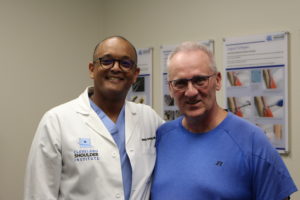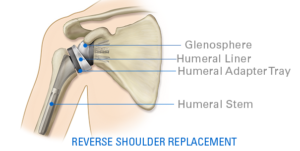At Cleveland Shoulder Institute, surgery is always the last resort. But when conservative efforts to control the pain have failed, and the pain is disrupting your daily life, a surgical intervention may be the best option to restore your health.
Most cases for a joint replacement are due to severe osteoarthritis that causes the cushion of cartilage between the bones to wear down. The extreme pain that results from this lack of cartilage and bone on bone interaction can be corrected by a total joint replacement.
In addition to pain, another factor to consider is your mobility. When you are no longer able to perform simple, daily movements with your arm, such as reaching up to grab a jar off a shelf, it’s time to consult with a specialist. An orthopedic specialist is the best place to start to properly diagnose and treat conditions of the joints, muscles and bones.
“With my patients, I know it’s time, when they have hit the proverbial wall of pain,” said Reuben Gobezie, MD, Founding Director of the Cleveland Shoulder Institute. “The patient makes the decision to have the surgery based on how much the pain and mobility are disrupting his or her life.”
One Patient’s Story: “Don’t Wait as Long as I Did”
Shoulder replacement surgery has been life-changing for many adults. In the case of Ken Roof, he realized after surgery that he had waited far too long to address the pain.
“I felt so much better after surgery, it gave me my life back,” Ken said. “My advice to others, is don’t wait as long as I did. Don’t let it get as damaged as I did. Go get it checked out.”
Ken, 66, lived with shoulder pain for more than two years just after he retired. He worked at Davis–Besse Nuclear Power Station for 35 years building scaffolding structures throughout the plant. It was his job to build the support systems for scientists and repairmen to access critical areas of the nuclear station.
Decades spent lifting, reaching, pounding and carrying heavy weight left its mark on his joints. The pain in both shoulders got to the point that he could no longer complete the simplest of tasks such as putting on a jacket or reaching for a glass. It stopped him from golfing with friends and made his grandkids afraid they’d hurt him with a hug.
“My wife would warn the grandkids to be careful around me,” Ken said. “‘Don’t touch grandpa’s shoulder,’ she’d say, I hated it. I looked forward to finally retiring, and then the pain was so bad, I couldn’t enjoy it,” he said.
While both shoulders were painful, his right shoulder was excruciating. Pain through the night made it difficult for him to sleep.
A Diagnosis and a Second Opinion
Ken was diagnosed with severe osteoarthritis in both shoulders. His first orthopedist insisted he was too young for a replacement and just needed cortisone shots every four months. But the shots did not stop the pain. He begged his family doctor for a referral to a second orthopedic surgeon and found his way to Dr. Gobezie.
Here he had his first CT scan that confirmed not only did he have osteoarthritis, but his right shoulder was half out of its socket. Dr. Gobezie assured him he was not too young for shoulder replacement surgery and asked him to “pick one” to select which shoulder he wanted to work on first.
“For some reason, at that moment, I got very emotional and started crying,” Ken said. “I don’t normally do that, but I was in such pain, and my life was becoming so limited. I saw a possibility to get out of this pain and improve my life.”
Reverse Total Shoulder Replacement
Ken had a reverse total shoulder replacement on his right shoulder and scheduled surgery for the left shoulder to occur exactly nine weeks later, the minimum time to wait when having both shoulders replaced.
The reverse total shoulder replacement changes the orientation of the shoulder so that the normal socket (glenoid) now is replaced with an artificial ball, and the normal ball (humeral head) is replaced with an implant that has a socket into which the artificial ball rests. This type of design completely changes the mechanics of the shoulder and enables the artificial joint to function when the rotator cuff is either absent or when there is significant bone loss.
The benefit of the reversal of the shoulder joint is that it allows the deltoid muscle to lift the shoulder instead of the rotator cuff, which cannot lift due to irreparable tear. Reversing the ball and socket changes the mechanics of the shoulder to improve active range of motion and strength. The result is that the patient can raise his/her arm higher and even sometimes overhead.
Following the surgeries, Ken was diligent about his rehabilitation exercises. Today, he has excellent range of motion lifting his arms up, and he feels better than he has in years.
“I am very blessed and fortunate that this man did my surgeries,” Ken said. “He gave me my retirement back. I’m thankful for my quality of life. If there is one thing I could share with others, it’s do not wait to take care of the pain.”
Possible Consequences of Waiting
Ken observed a major difference in how his right shoulder healed compared to his left, which did not have as much arthritic damage. “The post-surgery healing went much faster in my left shoulder because it was not as damaged as the right. My left shoulder recovered in just three days, while the right one took six weeks. I wish I had not lived with the pain for so long,” Ken said.
Simple daily activities no longer slow him down. “I get dressed fine and I can do things like reach up and screw in a lightbulb with no problem. I even go to the gym regularly and have lost 65 pounds since the surgery.”
But the best part now is that he can play with his grandkids without feeling so fragile. “They don’t have to be careful around me anymore,” Ken said. “Now they say, ‘Grandpa’s got his strength back!’ God bless Dr. Gobezie. This has been a very dramatic change in my life. It has improved me 100 percent.”
“This has been a very dramatic change in my life. It has improved me 100 percent.”

Dr. Gobezie and Ken Roof
at a follow up visit.
The Cleveland Shoulder Institute treats patients with all types of shoulder and elbow disorders resulting from traumatic injuries, arthritis, instabilities, rotator cuff and sports-related injuries. Led by nationally recognized Orthopedic Surgeon Reuben Gobezie, MD, the institute provides both surgical and non-operative treatments.
Dr. Gobezie is one of the country’s top specialists in advanced arthroscopic and open surgical techniques to restore damaged joints, ligaments and bones. He is also one of the most experienced and highest volume shoulder surgeons in the country. A number of studies have shown that surgical volume, the number of surgeries a surgeon performs each year, is a strong predictor of patient outcome. The more surgeries that a doctor and his surgical team performs, the better the results for patients.
Dr. Gobezie is Founding Director of both Cleveland Shoulder Institute and Regen Orthopedics.







